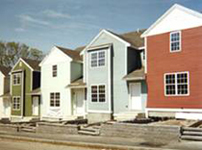Kotsopoulos S, Ph.D. Dissertation, Massachusetts Institute of Technology, 2005



2. The Studio Exercise
The examination of housing projects is standard part of the architecture curriculum. Therefore, a studio exercise on
housing is ideal for introducing rule-based compositional techniques to students. The present exercise is based
on a housing competition sponsored by the Habitat For Humanity (HFH) in the summer of 2002 in Boston,
Massachusetts. The HFH describes the goal of the competition as: “the building of simple, decent, affordable
houses”. The program calls for adaptable types of 2, 3 and 4-bedroom houses without determining the square-
footage of rooms or house types. All houses include: primary covered entrance, circulation, dining area, living area,
at least one full bathroom, kitchen, and bedrooms. A minimum living space limit for all house types is suggested:
900 s. f. for 2-bedroom apartments, 1050 s. f. for 3-bedroom apartments, and 1150 s. f. for 4-bedroom apartments.
Further, the organizers do not designate specific sites, but offer several possible ones. Small, quadrilateral lots
less than 5000 s. f. are an option, but lots larger than 20000 s. f. with complex shapes are also typical.

generate basic arrangements (partis) for possible designs. From each selected parti the students develop several
plan layouts and 3d models. The last part of the exercise is dedicated to the refinement of selected layouts and
the addition of certain tectonic details (walls, windows, doors, stairs, etc.)